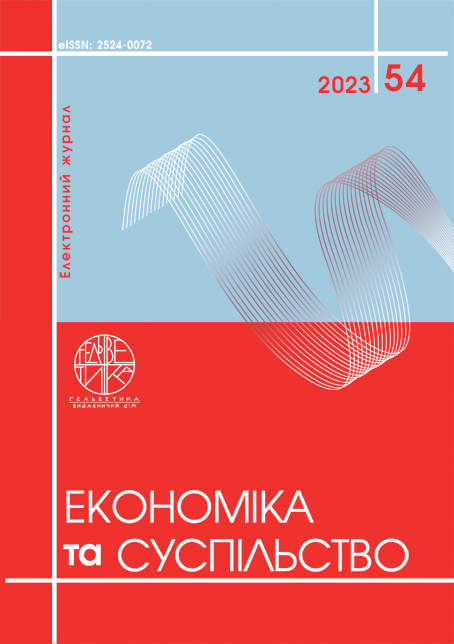INSTITUTIONAL BASIS OF THE ECONOMIC POLICY OF LATIN AMERICAN COUNTRIES
Abstract
The analysis of the institutional foundations of the economic policy of the newly industrialized countries of Latin America (Argentina, Brazil, Mexico) is carried out in the article. The generalized experience of Latin American countries proves that the foundations for the formation of the economic policy of these countries are laid in the colonial period under the influence of the mother countries of Spain and Portugal. Moreover, they were mainly based on the dominance of the colonizers, which had a corresponding effect on the nature and use of natural resources, the formation of social institutions, the establishment of foreign trade and financial relations of the countries of the Latin American region, even after they gained independence. With this in mind, it are founded that countries have been “path dependent”, once an economy is on a certain path, it is very difficult to drastically change direction due to the built-in characteristics of societal attitudes and institutions. It is revealed that the peak of economic growth of the newly industrialized countries was achieved due to the industrialization policy aimed at import substitution. However, its successes were not long lasting, including due to the lack of effective social institutions and “dependent development”, when the countries of Latin America had to adapt to the logic of the development of the leaders of the world economy. They were, in particular, to create a powerful state sector in a number of economic sectors in order to support import-substitution industrialization, although the creation of such a sector was largely artificial in nature. It is summarized that the institutional foundations of economic growth in new industrial countries of Latin American region, especially the development of effective institutions such as trade unions and political parties, were and still are quite limited. This causes a number of negative socio-economic effects in the society and complicates the formation of the state policy of economic growth, since there are no forces in the society capable of overcoming the formed economic dependence and backwardness.
References
Acemoglu D., Robinson A. Why Nations Fail: The Origins of Power, Prosperity, and Poverty. Crown Business. 2013. 546 p.
Allen R. Global Economic History: A Very Short Introduction. 2011. Oxford. 192 p.
Bianchi A., Takashi N. A Comparative Study on Economic Development between Asia and Latin America. JRP Series. Tokyo, Institute of Developing Economies. 1988. No. 67.
Жданова Л.Л. Інституційні основи індустріалізації і нової індустріалізації. Економічні науки: збірник наукових праць. Серія «Економічна теорія та економічна історія». Луцьк: Луцький НТУ, 2018. Вип. 15 (60). С. 62–71.
Zhdanova L. Institutions for development in socio-economic system of modern Ukraine. Economic innovations. 2020. Volume 22. Issue 1(74). Р. 72–79.
Clark G. A Farewell to Alms: A Brief Economic History of the World. Princeton university press. Princeton and Oxford. 2007. 432 p.
North D.C. The Ultimate Sources of Economic Growth. Explaining Economic Growth Essays in Honour of Angus Maddison. Amsterdam. Elsevier/North-Holland. 1993.
North D.C. Institutions. Institutional Change and Economic Performance. Cambridge University Press. Cambridge. Massachusetts. 1990.
Райнерт Е. Як багаті країни забагатіли... і чому бідні країни лишаються бідними. Видавництво «Темпора». 2015. 444 с.
Szirmai A. (Eds.), Naude W. (Eds.) and Alcorta L. (Eds.) Pathways to Industrialization in the Twenty-First Century. New Challenges and Emerging Paradigms. Oxford University Press. 2013. 443 p.
OECD et al. Latin American Economic Outlook 2021: Working Together for a Better Recovery, OECD Publishing, Paris. 2021. URL: https://doi.org/10.1787/5fedabe5-en.
The World Bank. 2022. Indicators. URL: https://data.worldbank.org/indicator.
Acemoglu D., Robinson A. (2013) Why Nations Fail: The Origins of Power, Prosperity, and Poverty. Crown Business. 546 p.
Allen R. (2011) Global Economic History: A Very Short Introduction. Oxford. 192 p.
Bianchi A. and Takashi N. (1988). A Comparative Study on Economic Development between Asia and Latin America. JRP Series, Tokyo, Institute of Developing Economies. No. 67.
Zhdanova L.L. (2018). Instytutsiini osnovy industrializatsii i novoi industrializatsii [Institutional foundations of industrialization and new industrialization]. Ekonomichni nauky: zbirnyk naukovykh prats. Seriia «Ekonomichna teoriia ta ekonomichna istoriia». Lutsk: Lutskyi NTU, Is. 15 (60), pp. 62–71. [in Ukrainian]
Zhdanova L. (2020). Institutions for development in socio-economic system of modern Ukraine. Economic innovations. Vol. 22, Is. 1(74), pp. 72–79.
Clark G. (2007) A Farewell to Alms: A Brief Economic History of the World. Princeton university press. Princeton and Oxford. 432 p.
North D.C. (1993). The Ultimate Sources of Economic Growth. Explaining Economic Growth Essays in Honour of Angus Maddison, Amsterdam, Elsevier/North-Holland.
North D.C. (1990). Institutions. Institutional Change and Economic Performance. Cambridge University Press. Cambridge. Massachusetts.
Rainert E. (2015) Yak bahati krainy zabahatily... i chomu bidni krainy lyshaiutsia bidnymy [How Rich Countries Got Rich ... and Why Poor Countries Stay Poor]. Vydavnytstvo «Tempora». 444 s. [in Ukrainian]
Szirmai A. (Eds.), Naude W. (Eds.) and Alcorta L. (Eds.) (2013). Pathways to Industrialization in the Twenty-First Century. New Challenges and Emerging Paradigms. Oxford University Press. 443 p.
OECD et al. (2021). Latin American Economic Outlook 2021: Working Together for a Better Recovery, OECD Publishing, Paris. URL: https://doi.org/10.1787/5fedabe5-en.
The World Bank (2022). Indicators. URL: https://data.worldbank.org/indicator.

This work is licensed under a Creative Commons Attribution 4.0 International License.


